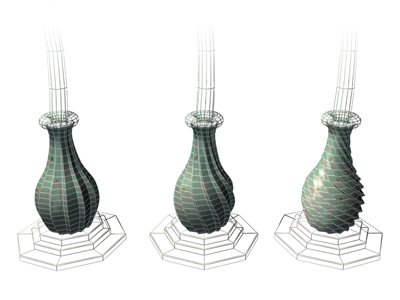Modifiers provide a way for you to sculpt and edit objects. They can change the geometry of an object, and its properties.

Example: effects of the Twist modifier on an object
The modifiers you apply to an object are stored in a stack. By navigating up and down the stack, you can change the effect of the modifier, or remove it from the object. Or you can choose to “collapse” the stack and make your changes permanent.
There are other general things to know about using modifiers:
- You can apply an unlimited number of modifiers to an object or part of an object.
- When you delete a modifier, all its changes to the object disappear.
- You can move and copy modifiers to other objects using controls in the modifier stack display.
- The order or sequence in which you add modifiers is important. Each modifier affects those that come after it. For instance, adding a Bend modifier before a Taper can give you distinctly different results than if you first added the Taper followed by the Bend.
How Modifiers Differ from Transforms
Modifiers and transforms differ in how they affect an object and the order in which they are applied to an object.
Transforms
The transform is the most basic of 3D manipulations. Unlike most modifiers, transforms are independent of an object’s internal structure, and they always act in world space. An object can carry any number of modifiers, but it always has only a single set of transforms.
The transforms of an object are expressed as a matrix of values that contain the following information:
- Position of the object center in world space
- Rotation of the object in world space
- Scale of the object along its local axes
The matrix is called the transformation matrix, and its information relates directly to the transforms Move, Rotate, and Scale. Applying one of these transforms alters the values in the transformation matrix.
Transforms have the following properties. They are:
- Applied to the entire object.
- Independent of their order of application. No matter how many times you transform an object, the results are stored as one set of values in the matrix.
- Applied after all object-space modifiers have been evaluated, but before the world-space modifiers. See Using the Modifier Stack.
Most transforms produce equal displacement along one or more axes of an object, or part of an object. For Move, Rotate, and Uniform Scale transforms, the displacement is equal along all three axes. When you rotate a box, all sides remain parallel. In general, all vertices keep the same relative position to one another. The exceptions are Squash and Non-Uniform Scale, which displace axes by different amounts.
Modifiers
Most modifiers allow you to perform operations on the internal structure of an object in object space. For example, when you apply a modifier such as Twist to a mesh object, the position of each vertex of the object is changed in object space to produce the twisting effect.
Modifiers can operate at the sub-object level, and are dependent on the internal structure of the object when the modifier is applied.
Modifiers have the following properties. They are:
- Applied to all of an object or part of an object (using a sub-object selection).
- Dependent on the order of application. Applying a Bend followed by a Twist produces a result different from applying a Twist followed by a Bend.
- Displayed as individual entries in the modifier stack, where you can turn them on or off, and change the order in which they're applied.
Some modifiers operate in world space. These use world-space coordinates, and are applied to the object after all object-space modifiers and transforms have been applied. Otherwise, they have the same overall properties as object-space modifiers.